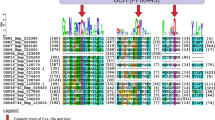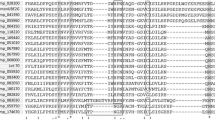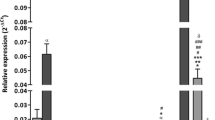Abstract
The ubiquitin-proteasome system is responsible for degradation of the majority of intracellular proteins in eukaryotic cells. The 26S proteasome proteolytic complex is composed of a 20S core particle responsible for protein degradation and the 19S lid which plays a role in the recognition of polyubiquitinated substrates. The 19S regulatory particle (Rps) is composed of ATPase (Rpt) and non-ATPase (Rpn) subunits. In this study, we analyzed the expression profile of 19S Rpt subunits in the larvae and adult stage of the Schistosoma mansoni life cycle. Conventional reverse transcriptase polymerase chain reaction (RT-PCR) revealed that the majority of the 19S Rpt subunits amplified at the expected molecular masses for various investigated stages. In addition, SmRpt1, SmRpt2, and SmRpt6 transcript levels were increased in 3 h-cultured schistosomula and reasonably maintained until 5 h in culture, as revealed by qRT-PCR. Phylogenetic analysis of 19S Rpt subunits showed high structural conservation in comparison to other Rpt orthologues. The mRNA expression profile of 19S Rpt subunits did not correlate with 26S proteasome proteolytic activity as judged by a 14C-casein-degrading assay, in the early cultured schistosomula. Taken together, these results revealed a differential expression profile for 19S Rpt subunits whose transcript levels could not be directly associated to 26S proteasome activity.




Similar content being viewed by others
References
Arya S, Sharma G, Gupta P, Tiwari S (2012) In silico analysis of ubiquitin/ubiquitin-like modifiers and their conjugating enzymes in Entamoeba species. Parasitol Re 111:37–51
Basch PF (1981) Cultivation of Schistosoma mansoni in vitro. I. Establishment of cultures from cercariae and development until pairing. J Parasitol 67:179–185
Bedford L, Paine S, Sheppard PW, Mayer RJ, Roelofs J (2010) Assembly, structure, and function of the 26S proteasome. Trends Cell Biol 20(7):391–401
Botelho-Machado C, Cabral FJ, Soares CS, Moreira EB, Morais ER, Magalhães LG, Gomes MS, Guerra-Sá R, Rosa JC, Ruller R, Ward RJ, Rodrigues V (2010) Characterization and mRNA expression analysis of PI31, an endogenous proteasome inhibitor from Schistosoma mansoni. Parasitol Res 107:1163–1171
Castro-Borges W, Cartwright J, Ashton PD, Braschi S, Guerra-Sa R, Rodrigues V, Wilson RA, Curwen RS (2007) The 20S proteasome of Schistosoma mansoni: a proteomic analysis. Proteomic 7:1065–1075
Dillon GP, Feltwell T, Skelton JP, Ashton PD, Coulson PS, Quail MA, Nikolaidou-Katsaridou N, Wilson RA, Ivens AC (2006) Microarray analysis identifies genes preferentially expressed in the lung schistosomulum of Schistosoma mansoni. Int J Parasitol 36:1–8
Fishelson Z, Amiri P, Friend DS, Marikovsky M, Petitt M, Newport G, Mckerow JH (1992) Schistosoma mansoni: cell-specific expression and secretion of a serine protease during development of cercariae. Exp Parasitol 75:87–98
Glickman MH, Ciechanover A (2002) The ubiquitin-proteasome proteolytic pathway: destruction for the sake of construction. Physiol Rev 82:373–428
González J, Ramalho-Pinto FJ, Frevert U, Ghiso J, Tomlinson S, Scharfstein J, Corey EJ, Nussenzweig V (1996) Proteasome activity is required for the stage-specific transformation of a protozoan parasite. J Exp Med 84(5):1909–1918
Guerra-Sá R, Castro-Borges W, Evangelista EAB, Kettelhut IC, Rodrigues V (2005) Schistosoma mansoni: functional proteasomes are required for development in the vertebrate host. Exp Parasitol 109:228–236
Guerrero C, Milenkovic T, Przulj N, Kaiser P, Huang L (2008) Characterization of the proteasome interaction network using a QTAX-based tag-team strategy and protein interaction network analysis. Proc Natl Acad Sci 105(36):13333–13338
Harrop R, Wilson RA (1993) Protein synthesis and release by cultures schistosomula of Schistosoma mansoni. Parasitology 107:265–274
Hua S, To WY, Nguyen TT, Wong ML, Wang CC (1996) Purification and characterization of proteasomes from Trypanosoma brucei. Mol Biochem Parasitol 78:33–46
Jolly ER, Chin CS, Miller S, Bahgat MM, Lim KC, DeRisi J, McKerrow JH (2007) Gene expression patterns during adaptation of a helminth parasite to different environmental niches. Genome Biol 8:R65
Livak KJ, Schmittgen TD (2001) Analysis of relative gene expression data using real-time quantitative PCR and the 2(−Delta Delta C(T)) method. Methods 25:402–408
Mathieson W, Castro-Borges W, Wilson RA (2011) The proteasome-ubiquitin pathway in the Schistosoma mansoni egg has development- and morphology-specific characteristics. Mol Biochem Parasitol 175:118–125
Mckerow JH, Salter J (2002) Invasion of skin by Schistosoma cercariae. Trends Parasitol 18:193–195
Nabhan JF, El-Shehabi F, Patocka N, Ribeiro P (2007) The 26S proteasome in Schistosoma mansoni: bioinformatics analysis, developmental expression, and RNA interference (RNAi) studies. Exp Parasitol 117:337–347
Neuwald AF, Aranvind L, Spouge JL, Koonin EV (1999) AAA: a class of chaperone-like ATPases associated whit assembly, operation and disassembly of protein complexes. Genome Res 9:27–43
Ogura T, Tanaka K (2003) Dissecting various ATP-dependent steps involved in proteasomal degradation. Mol Cell 11:3–5
Ogura T, Wilkinson CR (2001) AAA superfamily ATPases: common structure—diverse functions. Genes 6:575–595
Parker-Manuel SJ, Ivens AC, Dillon GP, Wilson RA (2011) Gene expression patterns in larval Schistosoma mansoni associated with infection of the mammalian host. PLoS Negl Trop Dis 5(8):e1274
Patel S, Latterich M (1998) The AAA team: related ATPases with diverse functions. Trends Cell Biol 8:65–71
Paugam A, Bulteau AL, Dupouy-Camet J, Creuzet C, Friguet B (2003) Characterization and role of protozoa parasite proteasomes. Trends Parasitol 19:55–59
Paula FM, Castro-Borges W, Pereira Júnior OS, Gomes MS, Ueta MT, Rodrigues V (2009) The ubiquitin–proteasome system in Strongyloididae. Biochemical evidence for developmentally regulated proteolysis in Strongyloides venezuelensis. Parasitol Res 105(2):567–576
Protasio AV, Tsai IJ, Babbage A, Nichol S, Hunt M et al (2012) A systematically improved high quality genome and transcriptome of the human blood fluke Schistosoma mansoni. PLoS Negl Trop Dis 6(1):e1455
Robertson CD (1999) The Leishmania mexicana proteasome. Mol Biochem Parasitol 103:49–60
Saitou N, Nei M (1987) The neighbor-joining method: a new method for reconstructing phylogenetic trees. Mol Biol Evol 4:406–425
Scholze H, Frey S, Cejka Z, Bakker-Grunwald T (1996) Evidence for the existence of both proteasomes and a novel high molecular weight peptidase in Entamoeba histolytica. J Biol Chem 271:6212–6216
Seol JH, Park SC, Ha DB, Chung CH, Tanaka K, Ichihara A (1989) Na+, K + -specific inhibition of protein and peptide hydrolyses by proteasomes from human hepatoma tissues. FEBS Lett 247:197–200
Shaw MK, He CY, Roos DS, Tilney LG (2000) Proteasome inhibitors block intracellular growth and replication of Toxoplasma gondii. Parasitology 121:35–47
Smithers SR, Terry RJ (1965) The infection of laboratory hosts with cercariae of Schistosoma mansoni and the recovery of the adult worms. Parasitology 55:695–700
Stirewalt MA (1974) Schistosoma mansoni: cercaria to schistosomule. Adv Parasitol 12:115–182
Tamura K, Dudley J, Nei M, Kumar S (2007) MEGA4: molecular evolutionary genetics analysis (MEGA) software version 4.0. Mol Biol Evol 24:1596–1598
Verma R, Chen S, Feldman R, Schieltz D, Yates J, Dohmen J, Deshaies RJ (2000) Proteasomal proteomics: identification of nucleotide-sensitive proteasome-interacting proteins by mass spectrometric analysis of affinity-purified proteasomes. Mol Biol Cell 11(10):3425–3439
Voges D, Zwickl P, Baumeister W (1999) The 26S proteasome: a molecular machine designed for controlled proteolysis. Annu Rev Biochem 68:1015–1068
Acknowledgments
This work was supported by grants from Conselho Nacional de Pesquisa e Desenvolvimento, Fundação de Amparo a Pesquisa do Estado de São Paulo, and Coordenadoria de Aperfeiçoamento de Pessoal de Nível Superior. The authors are grateful to Elenice Macedo and Olinda Mara Brigato for their technical assistance.
Author information
Authors and Affiliations
Corresponding author
Rights and permissions
About this article
Cite this article
Pereira-Júnior, O.S., Pereira, R.V., Silva, C.S. et al. Investigation on the 19S ATPase proteasome subunits (Rpt1–6) conservation and their differential gene expression in Schistosoma mansoni . Parasitol Res 112, 235–242 (2013). https://doi.org/10.1007/s00436-012-3130-4
Received:
Accepted:
Published:
Issue Date:
DOI: https://doi.org/10.1007/s00436-012-3130-4




